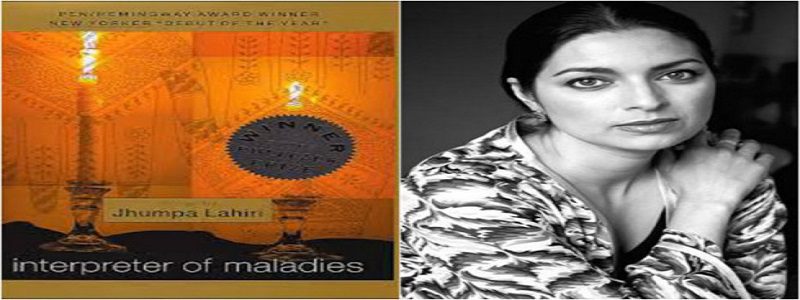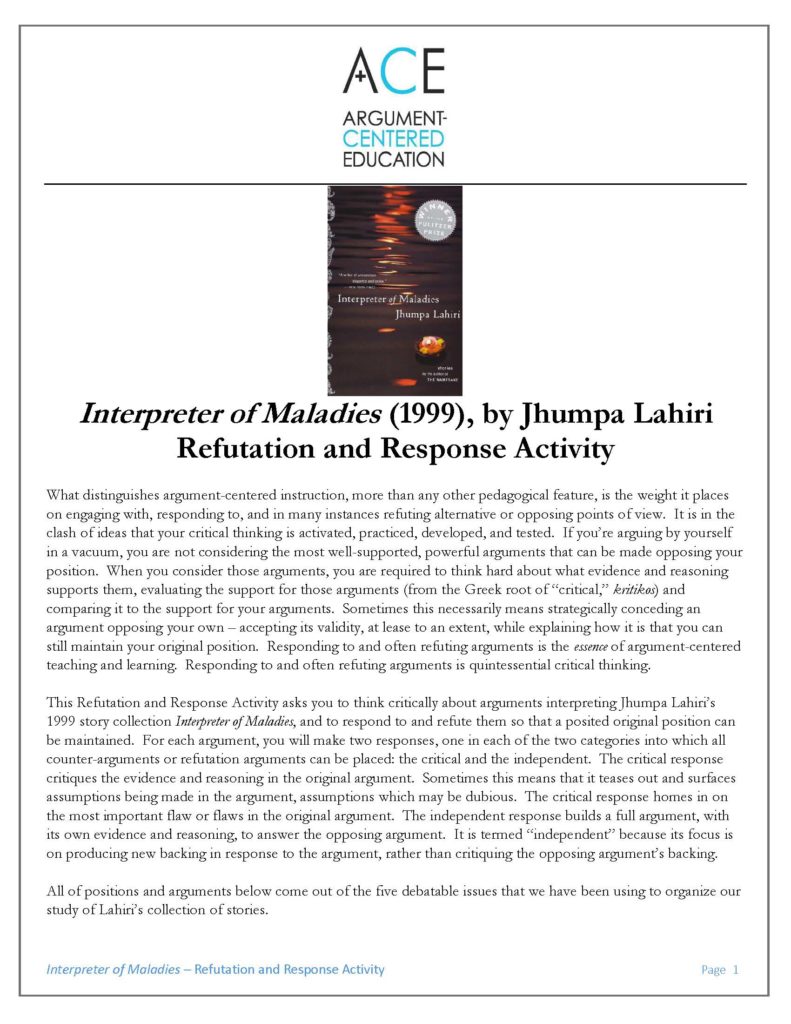
Exercising Response and Refutation in Interpreting ‘Interpretater of Maladies’
The Bengali-born American writer Jhumpa Lahiri burst on the literary scene with her first collection of short stories, Interpreter of Maladies, published in 1999, when Lahiri was in her early 30s. The collection, which gathers stories published in The New Yorker and less prominent literary magazines, has sold 15 million copies worldwide, and won the 2000 Pulitzer Prize for Fiction, as well as the Hemingway/PEN Award. Lahiri launched a literary career with this masterful collection in which she has both been very widely read and very highly lauded. Among other honors, she was named by President Obama in 2010 to the Committee on Arts and Letters, a position she resigned in 2017 to protest President Trump’s anti-immigrant rhetoricI worked with a partner high school’s English department this past year to argumentalize its unit on Interpreter of Maladies for its World Literature and Asian-American Literature courses. Lahiri’s collection, and her oeuvre more generally, focus on the American immigrant experience, especially the bifurcated subjectivities of Indian-Americans. We organized our argument-centered instruction on this work around five debatable issues.

In working with my partner schools I have increasingly found it useful to distill longer debatable issue prompts into pithy debatable questions. For this Lahiri collection, those five distilled debatable questions are these.
Is the collection’s depiction of Indian-Americans positive or critical and negative?
Are many of the stories’ endings actually ambiguous?
Do Lahiri’s characters succeed in blending their Indian and American cultural heritage?
Is Lahiri a romantic about marriage?
Which motif in the collection is the most important?
We worked on a set of selected passages that would function in the argument-centered unit as an evidence set, all of the examples in which are aligned to one or the other position on one or the other debatable issues. Students can of course go beyond the selected passages, but they can use the passages as a guide to understanding what evidence should look like to support arguments to develop an interpretive position.

We conducted a number of other argument-centered activities and implemented an argument writing assessment, but one of the central objectives of the unit was to build students’ critical thinking skills in their interpretive readings, which meant that we wanted to design and implement an activity focused on responding to and sometimes refuting opposing interpretive readings of the stories.
What distinguishes argument-centered instruction, more than any other pedagogical feature, is the weight it places on engaging with, responding to, and in many instances refuting alternative or opposing points of view. It is in the clash of ideas that your critical thinking is activated, practiced, developed, and tested. If a student is arguing by themselves in a vacuum, they are not considering the most well-supported, powerful arguments that can be made opposing their position. When they consider those arguments, they are required to think hard about what evidence and reasoning supports them, evaluating the support for those arguments (from the Greek root of “critical,” kritikos) and comparing it to the support for their arguments. Sometimes this necessarily means strategically conceding an argument opposing their own – accepting its validity, at lease to an extent, while explaining how it is that they can still maintain their original position. Responding to and often refuting arguments is the essence of argument-centered teaching and learning. Responding to and often refuting arguments is quintessential critical thinking.
This Refutation and Response Activity that we developed (and is downloadable below) asks students to think critically about arguments interpreting Jhumpa Lahiri’s 1999 story collection Interpreter of Maladies, and to respond to and refute them so that a posited original position can be maintained. For each argument, students make two responses, one in each of the two categories into which all counter-arguments or refutation arguments can be placed: the critical and the independent. The critical response critiques the evidence and reasoning in the original argument. Sometimes this means that it teases out and surfaces assumptions being made in the argument, assumptions which may be dubious. The critical response homes in on the most important flaw or flaws in the original argument. The independent response builds a full argument, with its own evidence and reasoning, to answer the opposing argument. It is termed “independent” because its focus is on producing new backing in response to the argument, rather than critiquing the opposing argument’s backing.
All of positions and arguments in the activity come out of the five debatable issues above that we used to organize our study of Lahiri’s collection of stories.
We asked students to take a close look at this model. Then for each of the questions, we asked them to assume they are taking the posited interpretive position, and that they are responding to the argument provided to support an opposing position. Students were asked to produce the two strongest responses to the argument that they can, one critical and one independent. The order of the two types of responses is up to them; think through what is the more logical or intuitive ordering. They can include strategic concession in your response, but be sure that they maintain their originally posited position. Students were asked to attempt to use different transition words or phrases in each one of your responses.
Model
Your position: Lahiri’s story collection Interpreter of Maladies depicts the alluring but ultimately unachievable aspiration of the immigrant to integrate and satisfyingly blend their native and mainstream American cultural heritages.
Opposing argument: The Indian-Americans in Interpreter of Maladies are generally highly successful people, an important societal metric for cultural adaptation. Sanjeev in “This Blessed House” is an upwardly-mobile professional, a new homeowner with other signs too of his and his wife Twinkle’s achievements. “‘You have enough money in the bank to raise three families,’ his mother reminded him when they spoke at the start of each month on the phone. ‘You need a wife to look after and love.’ Now he had one: a pretty one, from a suitably high caste, who would soon have a master’s degree. What was there not to love?” (148). The narrator, too, in the collection’s final story, “The Third and Final Continent,” rises from a lowly position as a poor immigrant in Boston to a highly successful engineer, over the story’s three decades. These characters have professional success that is far higher than the average level of success in this country. The final story’s narrator’s son is even admitted to Harvard University. In the United States, a person’s material, professional success is generally viewed as a proxy for their status in our culture; for this reason, most of the Indian-Americans in Lahiri’s fiction are symbols of an effective immigrant merging into the mainstream America. Through the indicators of some of the leading characters in Interpreter of Maladies, Lahiri seems to imply that Indian-Americans, despite their universally human problems, are exemplars of the American immigrant process of bringing together their prior and current cultural worlds.
First response (either critical or independent – circle one):
Transition/counter-claim: It is true that some of Lahiri’s leading characters are materially successful, but this doesn’t necessarily mean that they have been successful in blending their native culture with mainstream American culture.
Backing: Sanjeev, for instance, is affluent, but he is noticeably unhappy and socially awkward. His wife, Twinkle, is better able to blend with common American behaviors and norms, but that only serves to separate her from Sanjeev through the course of “This Blessed House.” And the end of the passage above – “What was there not to love?” – is likely intended ironically. The two should be in love, but Sanjeev hasn’t been able to adapt to his surroundings and his Americanized wife. Similarly, the narrator in the collection’s final story experiences interactions with Bostonians that leave both sides fairly perplexed. This country does value material success, but wealth isn’t equivalent to cultural integration, which is something more like feeling at home, at ease, comfortable, contented. Sanjeev, the final story’s narrator, and other Indian-Americans in this work are successful in certain important ways, but they don’t seem to feel at home, comfortable and content.
Second response (either critical or independent – circle one):
Transition/counter-claim: Additionally, there are Indian-American characters in Interpreter of Maladies that are more upfront about their being fractured between cultures.
Backing: In “Mrs. Sen,” for instance, the title character is a kind of symbol of the cultural awkwardness and disjointedness of the immigrant. Talking to the white American boy she is caring for, she asks a question with metaphoric cultural resonance for her. “‘Eliot, if I began to scream right now at the top of my lungs, would someone come?’ . . . Eliot shrugged. ‘Maybe.’ ‘At home that is all you have to do. Not everybody has a telephone. But just raise your voice a bit, or express grief or joy of any kind, and one whole neighborhood and half of another has come to share the news, to help with arrangements.’ By then Eliot understood that when Mrs. Sen said home, she meant India” (116). Mrs. Sen continues to call India home, despite being in America for years. She reveals to the boy Eliot one important reason for that in this passage: in India there is a greater sense of community, while America is much more individualistic. For Ms. Sen, and for other characters in Lahiri’s work, what they value most deeply is what divides them from their new residence in America, which is why it can never really feel like home to them.


